
Original Link: https://www.anandtech.com/show/2152
Tuniq Tower 120: Air Cooling to the Max
by Wesley Fink on January 15, 2007 12:01 AM EST- Posted in
- Cases/Cooling/PSUs
Improving system cooling has been a basic part of improving system performance since overclocking began. To squeeze more performance out of computer components users found ways to run them faster than specified. When they hit walls that prevented going even faster they found ways to better cool the components. The better cooling allowed for running the system even faster until another wall was encountered.
The quest for better cooling has been very creative, with solutions as simple as added fans, progressing to larger fans and heatsinks, peltier (thermoelectric cooling), water cooling, and finally the king of cooling - phase change. There are also the truly "benchmark only" cooling solutions like liquid nitrogen cooling. This is certainly not usable in a normal computing environment, but it is a favorite with competitive benchmarkers - who seem to live for the top of the ORB or the highest benchmark scores. This type of cooling is mainly built by the benchmarker and exists for that fleeting benchmark record that will be broken tomorrow by another benchmarker.
As cooling complexity goes up, so does the associated cost. At the extreme end you will find some top phase change units selling for $2,000 or more. You have to be a very serious overclocker or benchmarking enthusiast to invest that kind of money in cooling. Fortunately, you can achieve significant improvements in system cooling and overclocking for a lot less money. The sophistication of cheaper air and water cooling solutions has improved in recent years, and there have also been genuine efforts by the cooling industry to deliver better cooling performance at a lower price point.
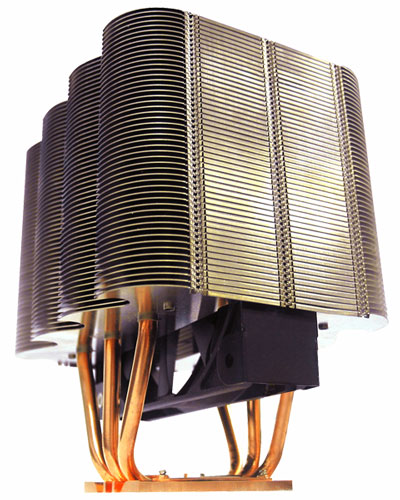
The Tuniq Tower 120 is one example of this. As imposing as the multi-finned, heat-piped Tuniq looks it is worth keeping in mind that the total cost of the Tuniq kit is only about $50. The question we will try to answer in this review is whether the Tuniq is effective at improving CPU cooling? If so, does the improved cooling allow higher overclocks than a stock cooling solution? Finally, the impact on system noise will be measured.
Does Cooling Matter With Core 2 and AM2?
In a recent review of the upcoming Core 2 Duo E4300, Anand found that the new 1.8GHz E4300 could be easily pushed to 3.37GHz with stock cooling, an astounding 87% overclock. Why then, would anyone want to worry about enhanced cooling? The answer is really simple. If you want to reach even higher overclocks - to potentially around 4 GHz - you need to look at improving CPU cooling.It is absolutely true that Core 2 Duo is not Pentium 4 when it comes to heat generation. The extremely hot and poor performing NetBurst processors have been replaced by Core 2 Duo, which runs very cool at stock speeds and overclocks like few chips we have ever seen in the evolution of the CPU. As a result life is good right now for Intel CPU users.
This year we will see if AMD can accomplish something similar with AM2 at 65nm. Current top 90nm AM2 processors have almost no "head room" at all, making concerns about overclocking relevant only for lower end AM2 chips. Early 65nm chips are also not stellar overclockers, but it is still early, and everyone expects that AMD can achieve overclocking results similar to C2D when their 65nm manufacturing is fully rolled out. It will be interesting to stop the speculation and actually see what AMD rolls out this year.
With relatively cool CPUs and massive overclocking capabilities it is worth looking at what happens with a stock processor and a stock heatsink/fan, at rated speed and when overclocked. We monitored CPU temperature on an NVIDIA 680i motherboard running an X6800 CPU with the stock Intel HSF - both at the stock speed of 2.93GHz, and at the highest stable overclock that would still allow gaming of 3.73GHz.
| X6800 CPU Operating Temperature with Standard Heatsink/Fan (Ambient Temperature 21C (70F) |
||
| CPU | System | |
| IDLE 2.93GHz | 41C (106F) | 32C (90F) |
| GAMING 2.93GHz | 56C (133F) | 33C (91F) |
| IDLE 3.73GHz | 56C (133F) | 37C (99F) |
| Gaming 3.73GHz | 71C (160F) | 38C (100F) |
While temperatures are dramatically improved compared to P4 NetBurst processors, it is clear that temperatures do increase rapidly as the overclock increases. At the highest overclock of 3.73GHz idle temperature had increased to 56C (133F) and stressed temperature rises to 71C (160F).
At this 3.73GHz overclock we suspect that the biggest handicap to further overclocking is CPU cooling. However, this is a question that can only be answered with a closer look at the performance of the Tuniq Tower 120. In the end we buy improved coolers for better cooling in most performance configurations. This improved cooling should theoretically allow even higher overclocks of the CPU. If the cooler you are considering does not cool better and/or improve overclocking, there is absolutely no justification at all for buying the cooling solution.
Sunbeam Tuniq Tower 120
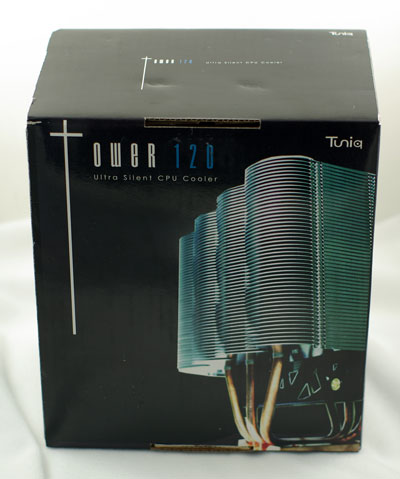
The Tuniq Tower 120 is manufactured by Sunbeam Company, a company based in Taiwan with manufacturing in mainland China. Sunbeamtech was founded in 2000, and the company specializes in PC modding, performance enhancement solutions, and PC cases. Tuniq is a subsidiary of Sunbeam, producing coolers like the Tuniq Tower 120 and specialized PC cases.

The Tower 120 consists of a massive 120mm 9-blade fan in the core of three closed heatpipe loops cooled with a huge number of thin aluminum fins for heat dissipation. The package comes with the special 9-blade fan, a small tube of high performance thermal grease, a fan controller that can mount in an empty expansion slot, and the adapter plate for Intel Socket 775 or AMD K8 (939/940/754).
The Tuniq is very heavy compared to standard heatsinks, which generally fall in the 400g to 650g weight range. At 798g without the fan you will find the final operating weight of the Tuniq 120 close to a kilogram (2.2 lbs). However, this is in line with coolers that take a similar approach to cooling like the Scythe Infinity.
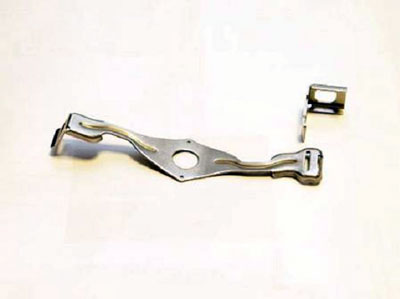
The package does NOT include the adapter for the AMD AM2 processor, but Tuniq tells us the Tower 120 will work on AM2 by using the Zalman ZM-OC1 adapter, which is pictured above. This can be purchased as an accessory from Zalman retailers.
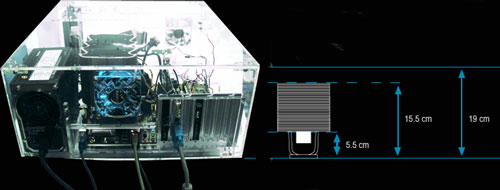
The Tuniq Tower 120 is a massive heatsink, designed to fit mid-tower and full-tower cases. At first glance you may wonder how it could possibly fit in a case, but the height is a bit less than the dimensions of a standard case and the Tuniq will definitely fit a standard case. While the cooler is very large in both width and length it is small at the base. As a result the bulk is above most onboard components around the CPU socket. The bottom line is the Tuniq will fit most motherboards with no problems.
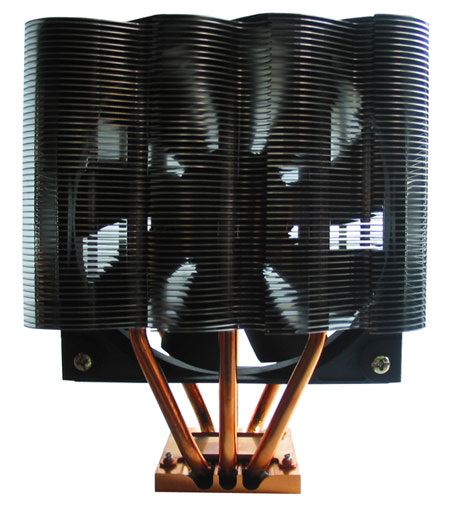
While any 120 mm fan can be used with the Tuniq, the stock fan has 9-blades instead of the more common 7-blade design. This is said to move more air at the same RPM, which allows the fan to be effective at low speeds that are also very quiet. Tuniq strongly encourages that you use the stock fan.

The unit comes standard with a slot-mount fan controller. Specifications indicate the fan dial adjusts fan speed from 1000 to 2000 RPM. These values are very low compared to smaller fans that must run at much higher speeds to be effective. The down-side of higher speed fans is that fan noise normally increases with speed. It is clear Sunbeam chose this huge 120mm fan with 9 blades to reduce noise in this design.
CPU Cooling Test Configuration
A primary requirement for any cooling test bed is a reliable utility for measuring CPU temperature and fan speed. The utility also must be usable while other programs are running so the impact of stress testing can be assessed. It is not really critically important that the temperature measurements be completely accurate, but results must be consistent and repeatable using the same test setup.After assessing a number of Intel 975/965 and NVIDIA 680i motherboards the decision was reached to use the NVIDIA 680i as the cooling test bed. This was primarily based on the excellent temperature measurement utility, NVIDIA Monitor, which is part of the nTune program.
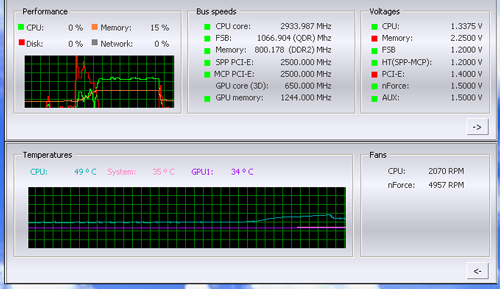
NVIDIA Monitor has a drop-down pane for temperature measurement which reports CPU, System, and GPU measurement. At this point we will concentrate primarily on CPU temperature with listings of system temps for reference. In addition to the real-time temperature measurement, NVIDIA Monitor also has a logging feature which can record temperature in a file in standard increments (we selected every 4 seconds). This allows recording of temperatures during testing and play back, for example, of stress test results that can then be examined when the stress tests are completed. There is also the handy reference of speeds and voltages in the top pane to confirm the test setup. These factors made NVIDIA Monitor on the 680i the ideal program for evaluating cooling.
Further tests using the program showed results were consistent over the same setup and repeatable under similar conditions. For all of these reasons NVIDIA Monitor on the NVIDIA 680i was used for testing cooling. Other components in the cooling test bed are generally the same as those used in our motherboard and memory test bed:
| Cooling Performance Test Configuration | |
| Processor: | Intel Core 2 Duo X6800 (x2 2.93GHz, 4MB Unified Cache) |
| RAM: | 2x1GB Corsair Dominator PC2-8888 (DDR2-1111) |
| Hard Drive: | Hitachi 250GB SATA2 enabled (16MB Buffer) |
| Video Card: | 1 x EVGA 7900GTX - All Standard Tests |
| Platform Drivers: | NVIDIA 9.53 |
| Video Drivers: | NVIDIA 93.71 |
| CPU Cooling: | Tuniq Tower 120 Intel Stock HSF for X6800 |
| Power Supply: | OCZ PowerStream 520W |
| Motherboard: | EVGA 680i SLI (nVidia 680i) |
| Operating System: | Windows XP Professional SP2 |
| BIOS | Award P23 (12/22/2006) |
The 680i motherboard with NVIDIA Monitor software will allow testing of the cooling efficiency of the cooler under test. We first tested the stock Intel cooler at standard X6800 speed, measuring the CPU temperature at idle and while the CPU was being stressed. We stressed the CPU by running continuous loops of the Far Cry River demo. The same tests were repeated at the highest stable overclock we could achieve with the stock cooler. Stable in this case meant the ability to handle our Far Cry looping for at least 30 minutes.
The same tests were then run on the cooler under test at stock, highest stock cooler OC speed, and the highest OC that could be achieved in the same setup with the cooler being tested. This allows measurement of the cooling efficiency of the test unit compared to stock and the improvement in overclocking capabilities, if any, from using the test cooler.
Noise Levels
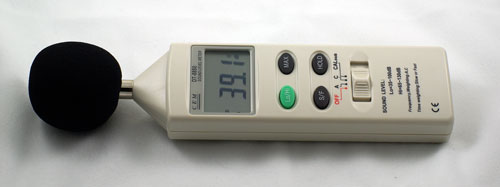
In addition to cooling efficiency and overclocking abilities, users shopping for CPU cooling solutions may also be interested in the noise levels of the cooling devices they are considering. Noise levels were measured in various configurations using a C. E. M. DT-8850 Sound Level meter. The C. E. M. meter can measure either A-weighted or C-weighted sound levels. All reported measurements are A-weighted since this is generally considered closer to the way the human ear actually perceives noise.
This meter allows sound level measurements from 35bdB to 130dB with a resolution of 0.1dB and an accuracy of +/- 1.5dB. This is sufficient for our needs in these tests, as measurement starts at the level of a relatively quiet room. Our own test room, with all computers and fans turned off, has a room noise level of 36.4dB. Our procedures for measuring cooling system noise are described on page 6 along with noise results comparing the stock Intel cooler to the Tuniq Tower 120.
Cooling Results
Both the retail Intel X6800 HSF and the Tuniq Tower 120 perform well at idle. Even at this base level, however, the effectiveness of the Tuniq Tower 120 is still clear.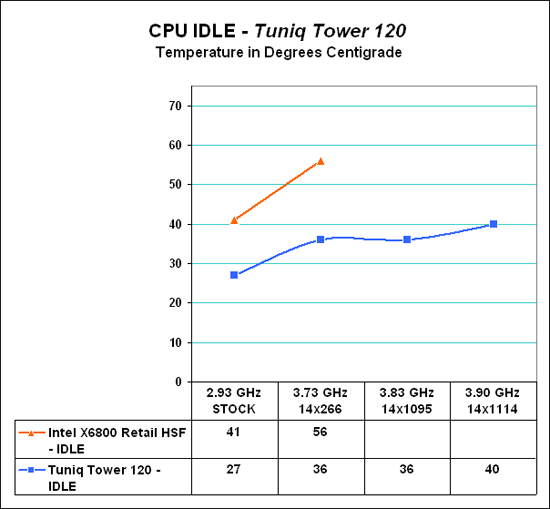
Where the very good Intel stock cooler keeps the X6800 at 41C, the Tuniq manages 27C, which is a huge difference at stock idle speeds. As the processor is pushed to its highest stable overclock using the retail HSF, the delta increases. At 3.73GHz the retail HSF is running at 56C, compared to an extremely cool 36C with the Tuniq at the same speed. The Tuniq allows the X6800 to reach even higher overclocks, to a stable 3.90 GHz. Even at the maximum overclock on this CPU with the Tuniq, idle temperature is still a modest 40C, less than the stock speed temperature of the retail Intel HSF.
It is very easy to measure the effectiveness of a cooling solution at idle - when the computer is doing nothing except running the temperature measurement program. It is more difficult, however, to effectively simulate a computer being stressed by all of the conditions it might be exposed to in different operating environments. Frankly, for most home users CPU power is most taxed with contemporary gaming. Therefore our stress test simulates running a demanding contemporary game.
The Far Cry River demo is looped for 30 minutes and the CPU temperature is captured at 4 second intervals with the NVIDIA monitor "logging" option. The highest temperature during the stress test is then reported. We did try other variations in "stressing" the CPU. One option was multi-tasking running Super Pi with the Far Cry River looping. This did almost halve gaming frame rates and push CPU utilization to near a constant 100%. The multitasking test setup, however, did not produce higher temperatures than looping the Far Cry River demo. For that reason, we settled on the simple stress test of looping a demanding Far Cry demo for 30 minutes.
Cooling effectiveness compared to the retail HSF improves even more with the Tuniq Tower 120 when measured under stress conditions. It appears the Tuniq becomes even more effective as greater demands are placed on cooling.
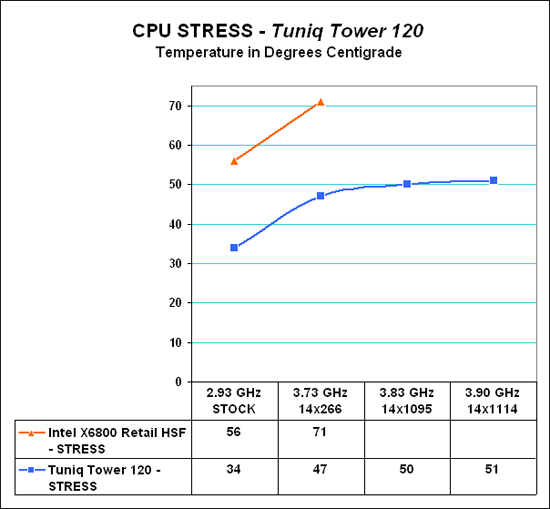
The delta under stress conditions at stock 2.93GHz speed is 22C - 56C to 34C. This compares to the delta at stock idle of 14C. As we saw with idle speeds, the difference increased as we overclocked, with a difference of 24C (71C to 47C) at the 3.73GHz overclock. With the Tuniq speed could be pushed another 170 MHz to 3.90 GHz, with the stress CPU temperature of 51C - still 5C below the stress temperature of the retail HSF at stock speeds.
It would be an understatement to say the performance of the Tuniq 120 is impressive in cooling the CPU. In all cases the Tuniq cooled the CPU better than the stock Intel retail HSF under the same conditions at stock speed. This was true even with the X6800 pushed about 1000MHz beyond the fastest available Core 2 Duo CPU.
As for the overclocking abilities of the CPU, they will vary at the top. This particular CPU does higher FSB speeds than any X6800 we have tested, but the 3.9GHz top speed is pretty average among this CPU cooled with the Tuniq Tower 120. A few of the other processors tested with the Tuniq reach just over 4 GHz, but the range has been 3.8 to 4.0GHz. Stock cooling generally tops out 200 to 400Mhz lower, depending on the CPU, on the processors tested in our lab.
Noise
Improved cooling and higher overclocks often come with additional noise. For some users the goal is maximum stable overclock, and they will live with the inconvenience of a louder system. For others silence is the most important factor, and these users will forgo overclocking if this increases system noise levels.Fortunately, both the stock Intel retail HSF and the Tuniq Tower 120 pay serious attention to the noise factor. Intel uses a low speed 80mm fan that runs at about 1100 RPM under normal operating conditions. The Tuniq Tower 120 uses a massive 120mm 9-blade fan that moves a lot of air and that can be manually adjusted between 1000 and 2100 RPM.
It should be pointed out that the fan speeds reported by NVIDIA Monitor are double the actual fan speeds. Fan speeds were measured and confirmed with the well-known SpeedFan, which is a free download. SpeedFan confirmed the adjustment range of the Tuniq Tower 120 to be 1000 RPM to 2100 RPM, which is just a bit better than the specified 1000 to 2000 RPM.
In looking at noise measurements, the test environment was first considered. The noise floor in the test room, with all computers and fans off, is 36.4dB. There are also virtually no power supplies that do not have a fan. While Zalman and perhaps others make expensive fanless PSUs, we are not aware of one that is larger than 500W, or that would be used for seriously overclocking a system. With that in mind the noise level of the system with all fans turned off except the power supply was measured. The power supply used for the cooling test bed was the OCZ PowerStream 520, which is one of the quieter high performance power supplies. The noise level of the power supply was 38.3dB from 24" (61cm) and 47dB from 6" (152mm).
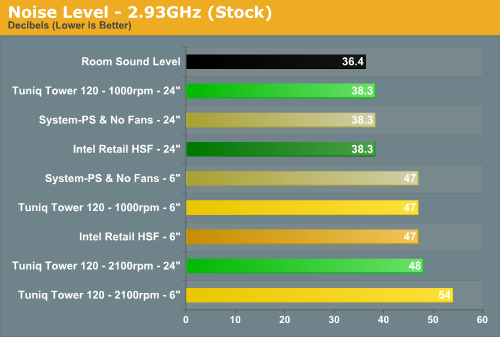
Measured noise levels in this chart should be considered worst case. Measurements were taken from an open side of a mid tower case 6" from the open HSF and 24" from the open HSF. Real world would be a completely closed case with a further reduction in noise.
The Intel retail HSF and the Tuniq Tower 120 at the 1000RPM setting were below the system noise floor at all tested speeds. That means they produced noise levels that were below the noise already produced by the quiet OCZ 520w power supply.
As already pointed out the Tuniq Tower 120 comes with a rheostat for adjusting fan speed from 1000 to 2100 RPM. At 1000 RPM the Tuniq can be considered as good as silent, but noise does go up as fan speed is manually increased. At the highest speed from 24" away the Tuniq measured 48dB compared to the system "floor" of 38.3dB. At a 6" distance the difference was 54dB to 47dB. Keep in mind that the dB scale is logarithmic and not linear, so a 3dB increase represents a doubling of sound power. Some studies suggest that while the human ear can discern small differences in sound level, the human ear perceives a doubling of loudness at a 10dB increase. Others quote double the sound level as 6db. In either case the increased noise of the Tuniq at 2100 RPM will definitely be noticeable to almost any user.
In most cases the 1000 RPM setting of the Tuniq Tower 120 will cool very adequately and sat very low noise levels. We found no difference in cooling with 1000 or 2100 RPM up to 3.73GHz. Above this point the higher 2100 speed cooled about 2C to 5C cooler than the 1000 low-speed setting. The system still topped out at 3.9GHz on low speed, but at a bit higher temperatures. This, of course, is with the Core 2 Duo processor, which runs rather cool. Your results with other CPUs will vary from this.
In the end whether you choose silence or maximum cooling with a bit more noise is up to you. With the adjustable fan speed you can dial in what is tolerable to you - from silence to some noise but a bit better cooling. It is worth mentioning that noise remained below the system noise floor until a speed of about 1600 RPM was reached. Above that speed noise increased rapidly.
Final Words
Effective CPU cooling means lowering the processor temperature compared to the Intel retail HSF which comes with most Intel processors. If an after market cooling solution does not perform better than the kit heatsink, there is no real reason to buy it. A cooler CPU could result in a longer CPU life, but most users upgrade cooling to overclock even further than is possible with a stock HSF. The second characteristic of effective cooling, then, is that it allows a better overclock than the stock HSF.The Intel Core 2 Duo is unarguably the most overclockable CPU in the current market. It is therefore the logical processor for evaluating the effectiveness of cooling solutions. There is a problem, however, in that the stock Intel retail HSF is really very good at cooling and very quiet. Intel seems to have learned a lot about cooling in working with the incredibly hot Pentium 4 NetBurst processors and they have applied what they learned to cooling the Core 2 Duo, which is not nearly as demanding. This is just to put in perspective the fact that the average heatsink/fan is likely to have a difficult time outperforming the Intel retail HSF. It is a very good kit HSF.
Having said that, it is clear the Tuniq Tower 120 is definitely up to the task. At the highest stressed speeds we could reach with the Tuniq, it still performed better, under demanding gaming conditions, than the Intel HSF at idle. That is certainly not faint praise.
In the second part of our definition, the Tuniq Tower 120 allowed a 200MHz greater overclock than the Intel HSF with the top-line Core 2 Duo X6800. The final overclock with the X6800/Tuniq Tower 120 was a stable 3.90GHz - a 1000MHz boost over the 2.93GHz stock speed. This is with the fastest Core 2 Duo, and we know from other testing that you can get overclocks much higher than 1000MHz with lower C2D processors because your starting point is a lower CPU speed.
For those who also consider lack of noise at least as important as performance we can only say you will also find the Tuniq Tower 120 satisfying. At the lowest 1000RPM measured noise remained below the system floor all the way to the highest overclock of 3.9Ghz. In fact, measured noise generally remained below the system noise floor as long as the fan speed was kept below 1600 RPM. You can squeeze out a few more degrees of cooling at the highest and noisier 2100 RPM, and with some CPUs that will also translate into a higher overclock. Silence is in your control with the Tuniq, since the fan is only manually adjustable, and the kit comes with a slot mounted fan speed rheostat.
From both our criteria for effective cooling the Tuniq Tower 120 is an outstanding CPU cooler. It does what a cooler should do with exceptional performance at all tested levels. Our noise measurements also confirmed Sunbeam's claim that the Tuniq Tower 120 is an "Ultra Silent CPU cooler" - at least at the lower fan speeds.
The performance of this air cooler is beyond reproach, but we did find installation was often not much fun. You have to use a bottom plate for attaching the Tuniq through the Socket 775 mounting holes. This means the motherboard must be removed from the case to install the Tuniq. We wish Sunbeam could find a better way to mount, but we do prefer secure mounting of this large and heavy cooler to an easier solution that might be less secure.
The other issue is the top mounting plate, which must be mated to a pin on the back of the copper CPU mount. It requires a lot of maneuvering to line up those parts and the sharp cooling fins are ready to cut or slice your hand if you're not careful. We suggest you take your time and stop a while if you find you are getting frustrated. Once properly mounted you will be rewarded with some of the best air cooling performance you can find.
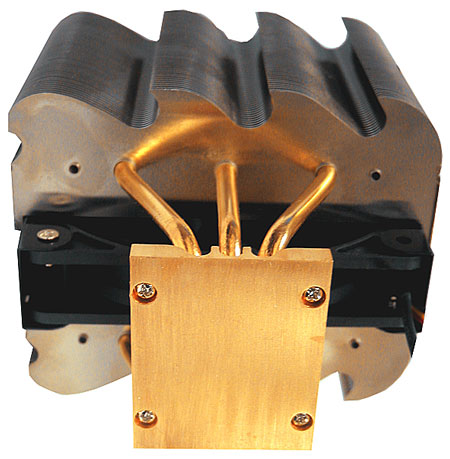
Last, many enthusiasts will tell you the smoother the contact surface the better the cooling. Frankly they will not be happy with the relatively rough copper bottom of the Tuniq. If that matters to you, then you will probably want to do a little surface polishing before mounting the Tuniq. An even better solution would be for Sunbeam to provide a more polished mounting surface on future Tuniq Tower 120s.
We have seen comments that claim the Tuniq is the best air cooler you can buy. Others have said the cooling is as effective as many water cooling solutions. We have more testing to do before we can support either of these claims. However, we can say with certainly that the Tuniq Tower 120 is one of the best cooling solutions we have ever tested. When you consider the cost is about $50 the Tuniq also has to be considered an incredible value. We can't think of many other products that cost $50 that will do as much for system performance as the Tuniq Tower 120.
We extend our sincere thanks to Frozen CPU for providing the Tuniq Tower 120 for review. Sunbeam has delivered a deceptively simple product that does what it is designed to do - provide exceptional cooling performance for a wide range of current processors and motherboards.







